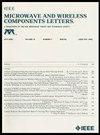应用于毫米波器件的精确内部电镀和3d打印工艺指南
IF 3.3
2区 工程技术
Q2 ENGINEERING, ELECTRICAL & ELECTRONIC
引用次数: 1
摘要
这封信详细介绍了使用电镀的3D打印WR-28和WR-10波导的金属化工艺。3D打印技术是立体光刻,因此打印的零件是基于塑料的。遵循两步金属化工艺:用镍喷涂进行预金属化,使零件导电,然后进行电镀工艺,强调改善所获得结果所需的化合物和数量,以及金属化时间和施加在零件上的电流。此外,还对制造偏差进行了测量和补偿。将获得的结果与模拟和商业波导截面进行了比较。测量结果显示,WR-28和WR-10的$S_{11}$分别低于−33和−21 dB。WR-28和WR-10的测量平均损耗分别约为1dB/m和4dB/m,相当于有效表面粗糙度低于$0.4~\mu\text{m}$的铜。本文章由计算机程序翻译,如有差异,请以英文原文为准。
Guidelines for Accurate in-House Electroplating and 3-D-Printing Processes Applied to mm-Wave Devices
This letter details the metallization process of 3-D-printed WR-28 and WR-10 waveguides using electroplating. The 3-D printing technique is stereolithography, so the printed parts are plastic-based. A two-step metallization process is followed: a premetallization with nickel spray to make the part conductive and a subsequent electroplating process, emphasizing the chemical compounds and quantities needed to improve the result obtained, as well as the metallization times and currents applied on the parts. In addition, manufacturing deviations are measured and compensated. The results obtained are compared with simulations and commercial waveguide sections. Measurements show $S_{11}$ below −33 and −21 dB for WR-28 and WR-10, respectively. Measured average losses are around 1 dB/m for WR-28 and 4 dB/m for WR-10, which is equivalent to copper with an effective surface roughness lower than $0.4~\mu \text{m}$ .
求助全文
通过发布文献求助,成功后即可免费获取论文全文。
去求助
来源期刊

IEEE Microwave and Wireless Components Letters
工程技术-工程:电子与电气
自引率
13.30%
发文量
376
审稿时长
3.0 months
期刊介绍:
The IEEE Microwave and Wireless Components Letters (MWCL) publishes four-page papers (3 pages of text + up to 1 page of references) that focus on microwave theory, techniques and applications as they relate to components, devices, circuits, biological effects, and systems involving the generation, modulation, demodulation, control, transmission, and detection of microwave signals. This includes scientific, technical, medical and industrial activities. Microwave theory and techniques relates to electromagnetic waves in the frequency range of a few MHz and a THz; other spectral regions and wave types are included within the scope of the MWCL whenever basic microwave theory and techniques can yield useful results. Generally, this occurs in the theory of wave propagation in structures with dimensions comparable to a wavelength, and in the related techniques for analysis and design.
 求助内容:
求助内容: 应助结果提醒方式:
应助结果提醒方式:


